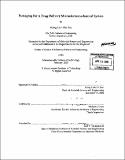Packaging for a drug delivery microelectromechanical system
Author(s)
Ho Duc, Hong Linh, 1978-
DownloadFull printable version (2.640Mb)
Other Contributors
Massachusetts Institute of Technology. Dept. of Materials Science and Engineering.
Advisor
Michael J. Cima.
Terms of use
Metadata
Show full item recordAbstract
Local drug delivery is a fast expanding field, and has been a center of attention for researchers in medicine in the last decade. Its advantages over systemic drug delivery are clear in cancer therapy, with localized tumors. A silicon microelectromechanical drug delivery device was fabricated for the purpose of delivering chemotherapeutic agents such-as carmustine, a potent brain cancer drug, directly to the site of the tumor. Limitations in the delivery capacity of the device led to the design of a new package. This package is made from thermally bonded Pyrex® 7740 frames that are anodically bonded to the drug delivery chip. It increases the capacity of the chip, is smaller than the previous package and possesses true hermeticity, because of the bonding processes involved. This work describes the fabrication steps of the new package and a problem with the thermal bonding of Pyrex® frames preventing the achievement of a package true to the original design. A temporary solution was devised and the completed package was tested with regards to its intended goals. It managed to increase the load capacity of the chip by a, factor of 10, with potential for more, while decreasing the overall size of the package. Short-term hermeticity was achieved for this package by using a UV-cured epoxy to bond some pieces, which was not in the original design. Future work will focus on finding a permanent solution to the aforementioned problem, and directions for it were suggested.
Description
Thesis (S.M.)--Massachusetts Institute of Technology, Dept. of Materials Science and Engineering, 2005. Includes bibliographical references (p. 52-55).
Date issued
2005Department
Massachusetts Institute of Technology. Department of Materials Science and EngineeringPublisher
Massachusetts Institute of Technology
Keywords
Materials Science and Engineering.